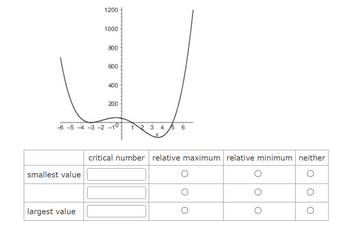
Advanced Engineering Mathematics
10th Edition
ISBN: 9780470458365
Author: Erwin Kreyszig
Publisher: Wiley, John & Sons, Incorporated
expand_more
expand_more
format_list_bulleted
Question
Use the graph of f ' to (a) identify the critical numbers of f, and (b) determine whether f has a

Transcribed Image Text:smallest value
1200
largest value
1000
800
600
400
-6-5-4-3-2-10
200
3 4 5 6
critical number relative maximum relative minimum neither
Expert Solution
This question has been solved!
Explore an expertly crafted, step-by-step solution for a thorough understanding of key concepts.
This is a popular solution
Trending nowThis is a popular solution!
Step by stepSolved in 3 steps with 3 images

Knowledge Booster
Similar questions
- Suppose f has a continuous derivative whose values are given in the following table. 8 9 10 10 11 12 13 14 15 16 17 ƒ' (x) 5 2 1 -2 -5 -3 -1 2 3 1 -1 X 7 (a) Estimate the x-coordinates of critical points of f for 7 ≤ x ≤ 17.arrow_forward2) Find the absolute minimum value on (0,0) for f(x) = 5+x+-arrow_forwardLl.30.arrow_forward
- D. What is the minimum value of f(x)?arrow_forwardb. Give an example of a function f and a point a such that Vf(a) det Hf (a) = 0 for each of the following two cases: i. where f(a) is either a minimum or a maximum; and ii. where f(a) is a saddle point. Explain why your examples meet the criteria specified. c. What fact from this semester's calculus studies has your pair of examples demonstrated? Explain your answer. - 0 andarrow_forwardLet f(x)=2x2-12x+8. Function f(x) has one minimum point at... Diketahui f(x)=2x²-12x+8. Fungsi f(x) memiliki satu titik minimum yaitu titik ... 1. O (3,10) 2. О (3,-10) 3. О (-3,-10) 4. O (-3,10)arrow_forward
arrow_back_ios
arrow_forward_ios
Recommended textbooks for you
 Advanced Engineering MathematicsAdvanced MathISBN:9780470458365Author:Erwin KreyszigPublisher:Wiley, John & Sons, Incorporated
Advanced Engineering MathematicsAdvanced MathISBN:9780470458365Author:Erwin KreyszigPublisher:Wiley, John & Sons, Incorporated Numerical Methods for EngineersAdvanced MathISBN:9780073397924Author:Steven C. Chapra Dr., Raymond P. CanalePublisher:McGraw-Hill Education
Numerical Methods for EngineersAdvanced MathISBN:9780073397924Author:Steven C. Chapra Dr., Raymond P. CanalePublisher:McGraw-Hill Education Introductory Mathematics for Engineering Applicat...Advanced MathISBN:9781118141809Author:Nathan KlingbeilPublisher:WILEY
Introductory Mathematics for Engineering Applicat...Advanced MathISBN:9781118141809Author:Nathan KlingbeilPublisher:WILEY Mathematics For Machine TechnologyAdvanced MathISBN:9781337798310Author:Peterson, John.Publisher:Cengage Learning,
Mathematics For Machine TechnologyAdvanced MathISBN:9781337798310Author:Peterson, John.Publisher:Cengage Learning,


Advanced Engineering Mathematics
Advanced Math
ISBN:9780470458365
Author:Erwin Kreyszig
Publisher:Wiley, John & Sons, Incorporated

Numerical Methods for Engineers
Advanced Math
ISBN:9780073397924
Author:Steven C. Chapra Dr., Raymond P. Canale
Publisher:McGraw-Hill Education

Introductory Mathematics for Engineering Applicat...
Advanced Math
ISBN:9781118141809
Author:Nathan Klingbeil
Publisher:WILEY

Mathematics For Machine Technology
Advanced Math
ISBN:9781337798310
Author:Peterson, John.
Publisher:Cengage Learning,

